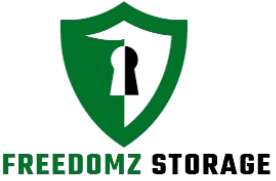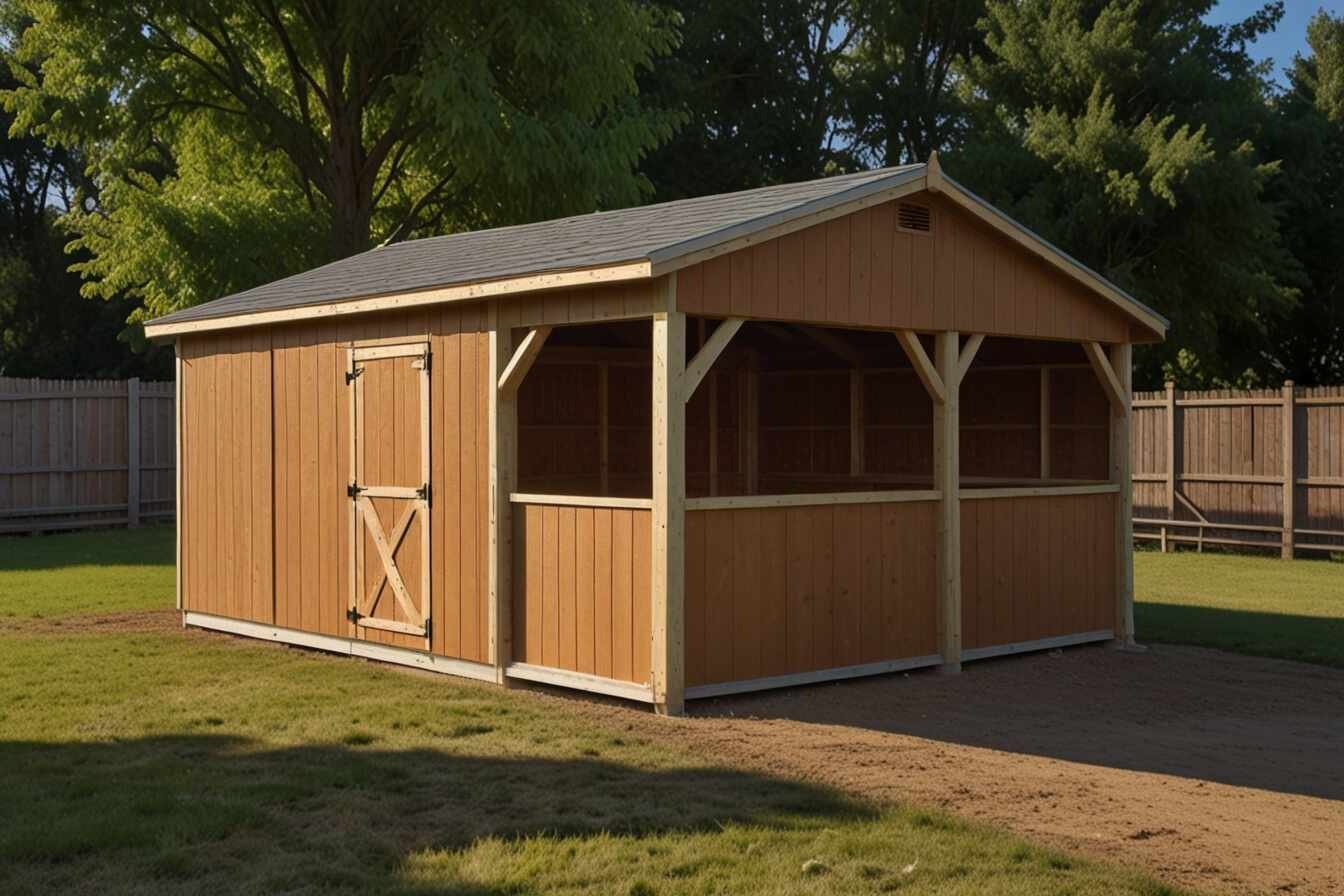How do I determine the appropriate size for my run in shed with overhang? In field of animal husbandry, providing proper shelter is vital for guaranteeing the welfare of our cattle.
One clever option that has gained appeal among farmers and equestrians alike is the run in shed with overhang.
This ingenious shelter combines the advantages of classic run in shed with additional safety and adaptability provided by an overhang.
In this complete tutorial, we’ll look at subtleties of this structure, including its characteristics, benefits, and the process of constructing and building one specifically for your requirements.
Exploring Features of run in Shed with Overhang
Here are the features of run in sheds with overhang, from board and batten construction to considerations for various livestock needs.
Board and Batten Construction: Durability and Aesthetic Appeal
Board and batten run in shed with overhang building style involves joining narrow hardwood boards (battens) to broader boards (boards), resulting in a unique pattern that not only improves the structure’s visual appeal but also its longevity.
Board and batten siding’s interlocking construction adds strength, making it ideal for withstanding the weather as well as wear and strain of everyday farm usage.
Run in Shed with Overhang Plans: Designing for Function and Comfort
When designing a run in shed with overhang, it’s important to begin with precise blueprints that include both utility and comfort.
Consider your livestock’s size, local weather, and any special demands or preferences you may have.
By carefully arranging your run in shed plans and adding aspects such as sufficient ventilation, abundant natural light, and simple access for cleaning and maintenance, you can create environment that supports your animals’ health and well-being.
Using Blueprint run in Shed Plans for Efficient Construction
Using blueprints or precise drawings may speed up the construction process and guarantee that your run in shed with overhang meets the highest requirements.
These plans usually include accurate measurements, material lists, and step-by-step directions for building the project.
Whether you’re a seasoned DIY supporter or employing experienced contractors, having a clear plan to follow can help keep the project on track and result in well-built and practical shelter for your animals.
Metal run in Sheds as Alternative Materials for Longevity
While wood is common material for building run in sheds, metal run in sheds provide alternatives with various benefits.
Metal shelters are extremely robust, resistant to decay, insect damage, and fire, making them ideal for long-term usage.
Furthermore, metal shelters require less upkeep and are simple to clean, making them perfect for busy farm owners.
When deciding between wood and metal for run in shed with overhang, consider your budget, climate, and aesthetic tastes.
Adding Tack Room: Improving Functionality for Equestrians
For horse owners, adding run in shed with tack room can significantly improve its utility. Tack room is a specific area for storing saddles, bridles, grooming supplies, and other equestrian equipment, ensuring that they are organized, clean, and conveniently available.
To maximize efficiency and convenience, plan your shed layout with your tack room’s size and layout in mind, as well as amenities like built-in shelves, hooks, and storage bins.
Portable Options: Flexibility to Meet Changing Needs
Among the primary benefits of shed with overhang is its adaptability. Portable run in shed, as opposed to permanent constructions, may be simply relocated to other positions on your property or even transported with you if you move.
This adaptability enables you to respond to shifting demands, whether you’re rotating pastures, growing your operation, or just reorganizing your farm structure.
When selecting a portable run in shed, look for features like skids or wheels for simple transport and anchoring options to maintain stability in windy weather.
Catering to Different Livestock: Considerations for Goat run in Shed
run in sheds are generally associated with horses, although they may also be used to shelter other livestock, such as goats.
When creating a run in shed with overhang for goats, there are few important factors to consider.
Goats are great escape artists, so protect the building with solid fence or gates to keep them from straying away.
Furthermore, goats have different dietary and behavioral requirements than horses, so include features like high feeding stations, safe hay racks, and climbing structures to keep them happy and healthy.
Benefits of Installing Overhang on Your run in Shed
Following are the benefits of adding overhang to your run in shed, from extended protection against the elements to enhanced comfort for your animals.
Increased Protection from the Elements
The biggest advantage of adding overhang to your run in shed is that it gives additional protection against the weather.
The overhang serves as a barrier, sheltering the shed’s entry from direct sunshine, rain, snow, and wind.
This helps to keep the sheds inside dry and pleasant, lowering the likelihood of moisture-related problems like mold, mildew, and decay.
Furthermore, the overhang provides a covered location for animals to seek refuge from heat of the sun during summer months, therefore reducing heat stress and sunburn.
More Storage Space for Feed and Equipment
In addition to sheltering animals, the overhang of run in shed may be used to store feed, equipment, and other supplies.
By utilizing the area beneath the overhang, you can keep these objects easily accessible while still shielding them from the outdoors.
Consider putting shelves, hooks, or storage bins to make most of this area while keeping it orderly and neat.
This not only improves efficiency in feeding and maintenance activities, but it also helps to extend the life of your equipment and supplies by keeping them dry and protected.
Increased Comfort for Animals
Another big advantage of adding overhang to your run in shed is that it gives more comfort for your animals.
The shaded space beneath the overhang provides a pleasant, sheltered location for animals to relax, graze, or seek protection from harsh weather.
This can assist to relieve stress and improve general health and well-being, especially on hot summer days or during heavy rain or snowfall.
You may provide a secure and welcome environment for your animals by making their shelter comfortable and enticing.
Increased the Overall Durability of Structure
Finally, adding overhang to your run in shed can increase its overall strength and longevity. The overhang offers an additional layer of protection for the shed’s entry, preventing rainwater from seeping in and causing structural damage over time.
Furthermore, the overhang serves to deflect wind and debris, lowering the chance of damage from storms or strong winds.
By purchasing run in shed with overhang, you can have peace of mind knowing that your shelter is made to last and will provide dependable protection for your animals for years to come.
Planning and Building run in Shed with Overhang
Get now the essential steps on run in shed with overhang plans, from assessing your needs and selecting materials to following step-by-step construction plans
Evaluate Your Needs and Available Space
Before beginning the building of run in shed, consider your needs and available space. Consider the quantity and size of animals you’ll be sheltering, the current weather conditions in your location, and any special features or amenities you desire.
This will assist you in determining perfect size, layout, and style for your shed, ensuring that it satisfies your requirements and blends smoothly into your surroundings.
Selecting Ideal Location for Your Shelter
Choosing the best site for your run in shed is important to ensure its operation and lifespan. Choose a flat, well-drained location of your land with enough room for the size of the shed you intend to build.
Ideally, the shed should be located away from low-lying regions prone to flooding and shielded from high winds and other environmental threats. When deciding where to build your shelter, consider availability of water, power, and fencing.
Choosing Materials and Gathering Tools
Once you’ve decided on the size and placement of your run in shed with overhang, you can begin gathering supplies and tools for construction.
Depending on your budget, tastes, and local construction standards, you may make your shed out of wood, metal, or combination of the two.
Choose high-quality, weather-resistant materials that are appropriate for outdoor usage and can survive regular wear and tear.
Also, gather all of the construction tools and equipment, such as saws, drills, hammers, and measuring devices.
Following Step-by-Step Construction Plans
With your supplies and equipment in hand, you may begin the construction process. If you’re utilizing pre-made plans or blueprints, make sure you follow them step by step.
Pay particular attention to dimensions, angles, and assembly instructions to ensure that your shed is erected properly and securely.
If you’re building a shed from scratch, sketch up a precise blueprint and make any required changes before beginning construction. To avoid accidents and injuries, always use protective gear and operate on stable, level surfaces.
Consider Customization Options for Your Specific Requirements
As you construct a run in shed, consider modifying the design to your specific needs and preferences.
Depending on your needs, you may want to include amenities like windows for ventilation, skylights for natural light, or walls to divide different portions of the shed.
Consider adding luxuries like waterers, feeders, or automatic lighting systems to make everyday duties more efficient and convenient.
By designing your shed to meet your specific needs, you can create a facility that not only offers shelter but also increases productivity and comfort for both you and your animals.
Read More: Shed with Loft and Porch Plans
Conclusion
Finally, run in shed with overhang is a versatile and practical option for giving shelter and safety to your animals.
Whether you’re raising horses, goats, or other livestock, this creative construction has various benefits, including prolonged weather protection, extra storage space, higher animal comfort, and increased overall longevity.
By carefully designing and building run in shed with overhang, you can provide a secure and comfortable environment for your animals to thrive year-round.
So, why wait? With help of Freedomz Storage, start working smartly and take your animal care to the next level now!
FAQ
Q: What is the definition of run in shed with overhang?
A: run in shed with overhang is shelter for animals, usually horses or cattle, with open front and roof extension (overhang) that provides extra protection from the weather.
Q: What materials are usually used to build run in sheds with overhang?
A: Wood is commonly used for traditional building, metal for durability, or combination of the two, depending on budget and choice.
Q: Can run in shed with overhang be portable?
A: Yes, portable alternatives are available, providing flexibility for changing demands and enabling for simple movement about the site.
Q: What cattle will benefit from run in shed with overhang?
A: While often used for horses, run in shelters with overhang may also accommodate other animals, such as goats, offering specialized shelter and protection.

